In the Late Cretaceous Period, the majestic Rapetosaurus roamed the ancient landscapes of Madagascar. This remarkable sauropod, named after a mythical giant from Malagasy folklore, offers a fascinating glimpse into a bygone era. Its discovery not only enriched our understanding of the diverse dinosaur fauna of Madagascar but also provided crucial insights into the evolutionary history of sauropods.
Rapetosaurus Key Facts
| Keyword | Fact |
|---|---|
| Pronunciation | rə-PAY-too-SOR-əs |
| Meaning of name | Rapeto Lizard |
| Group | Sauropod |
| Type Species | Rapetosaurus krausei |
| Diet | Herbivore |
| When it Lived | 72.1 to 66.0 MYA |
| Period | Late Cretaceous |
| Epoch | Maastrichtian |
| Length | 49.0 to 54.0 feet |
| Height | Approximately 10.0 feet |
| Weight | 11.35 tons |
| Mobility | Moved on all four |
| First Discovery | 1996 by Kristina Curry Rogers and colleagues |
| Described by | 2001 by Kristina Curry Rogers and Catherine A. Forster |
| Holotype | UA 8698 |
| Location of first find | Mahajanga, Madagascar |
Rapetosaurus Origins, Taxonomy and Timeline
Rapetosaurus, a name that resonates with the folklore of Madagascar, translates to ‘Rapeto Lizard’, a nod to the mythical giant Rapeto. This sauropod, belonging to the Titanosauria, represents a unique lineage within the vast and diverse sauropod clade. The type species, Rapetosaurus krausei, stands as a testament to the rich dinosaur fauna that once thrived in Madagascar.
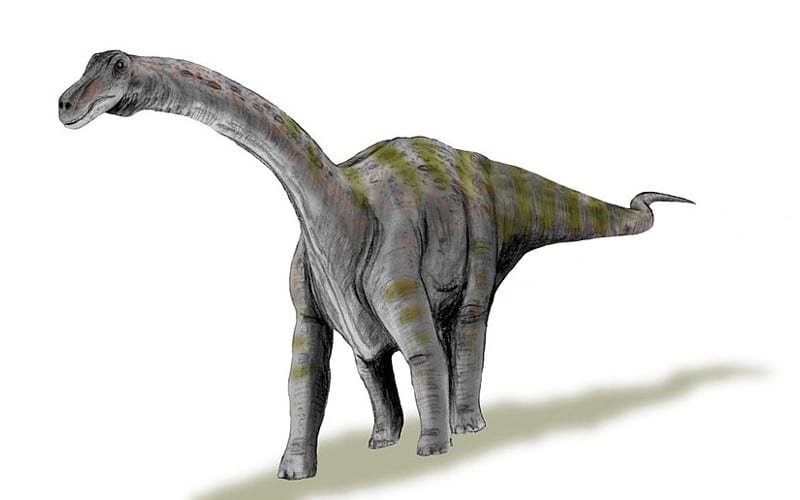
Taxonomically, this giant herbivore is classified within the Sauropoda, a group known for their enormous size and long necks. As a member of the Titanosauria, it was likely one of the biggest amongst the giants.
The timeline of Rapetosaurus spans the Maastrichtian Epoch of the Late Cretaceous Period, approximately 72.1 to 66.0 million years ago. This era marks a significant chapter in Earth’s history, just before the mass extinction event that ended the reign of the non-avian dinosaurs (birds, who are dinosaurs, somewhat survived the mass extinction and still thrive in our world today).
Listen to Pronunciation
Discovery & Fossil Evidence
The discovery of Rapetosaurus preserved in a fossil-rich rock formation in Mahajanga, Madagascar in 1996 by Kristina Curry Rogers and colleagues, marked a significant addition to the sauropod phylogenetic tree. The holotype, UA 8698, provided a wealth of information about this species. While subsequent finds have been limited, the initial discovery included well-preserved fossils that offered insights into its anatomy and lifestyle.
The fossils of Rapetosaurus include parts of the skull, vertebrae, and limbs, allowing paleontologists to reconstruct a detailed picture of its physical appearance. These remains have been crucial in understanding the evolutionary trajectory of sauropods in Gondwana during the Late Cretaceous.
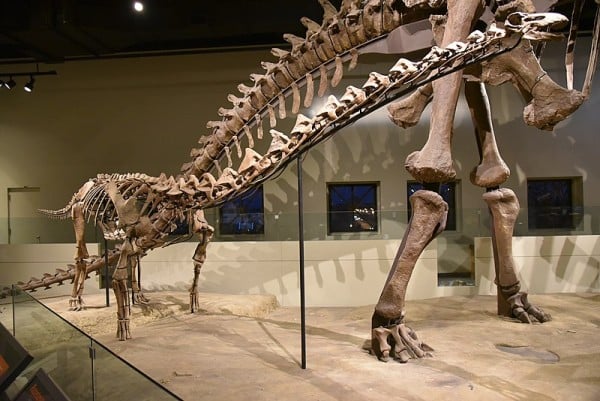 Rapetosaurus skeleton on display at the Field Museum of Natural History, Chicago, IL
Rapetosaurus skeleton on display at the Field Museum of Natural History, Chicago, IL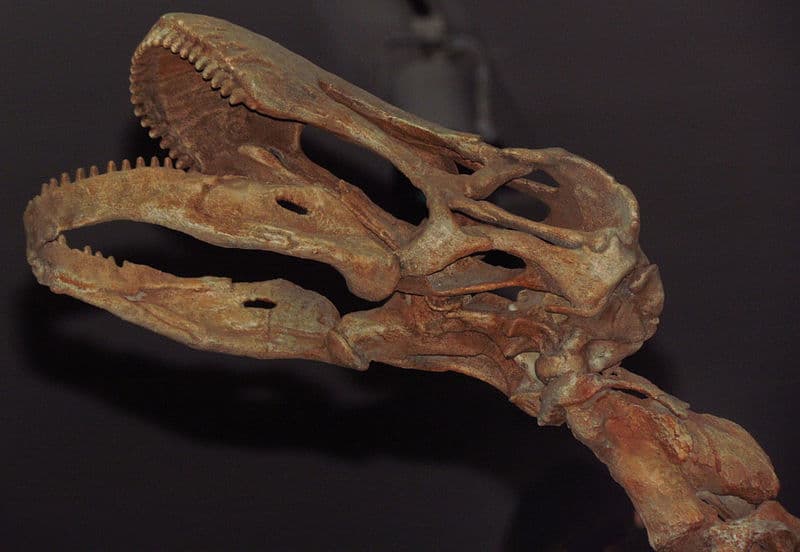 Rapetosaurus krausei, cast skull, Royal Ontario Museum, Toronto, Ontario, Canada
Rapetosaurus krausei, cast skull, Royal Ontario Museum, Toronto, Ontario, Canada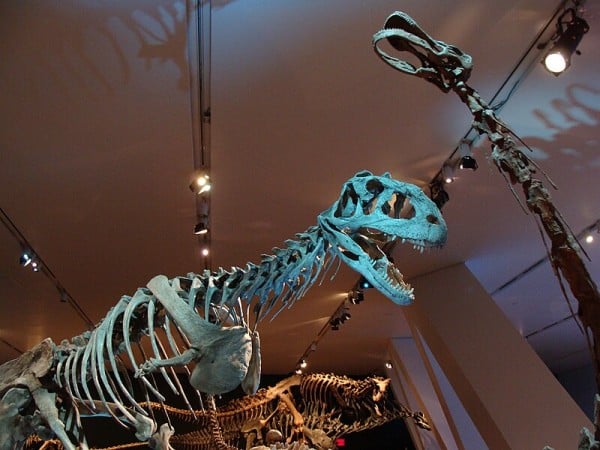 Mounted Majungasaurus and Rapetosaurus
Mounted Majungasaurus and Rapetosaurus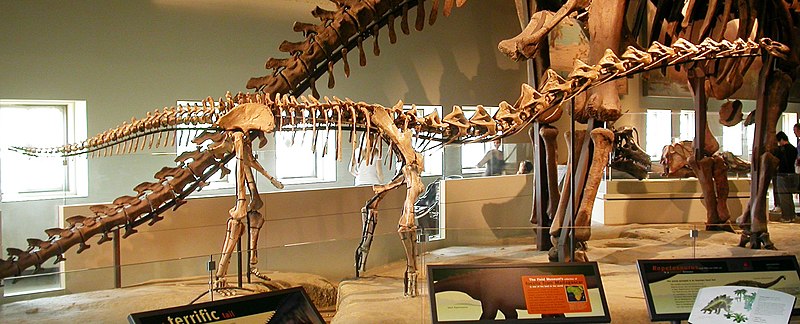 Skeleton of a juvenile Rapetosaurus, Field Museum.
Skeleton of a juvenile Rapetosaurus, Field Museum.
Rapetosaurus Size and Description
Rapetosaurus, a titanosaur of notable distinction, presents a fascinating blend of physical traits. While it shared the quintessential sauropod characteristics of a long neck and a massive body, its size and specific features set it apart from its colossal relatives.
Short description of Rapetosaurus
This dinosaur’s anatomy was a marvel of biology. It possessed a slender, tapering tail and an extraordinarily elongated neck, reminiscent of the grandeur of sauropods. Its head, akin to that of a diplodocid, featured a long, narrow snout with nostrils positioned atop the skull. Adapted for a herbivorous diet, its small, pencil-like teeth were adept at stripping leaves from trees, though not suited for chewing. The overall body structure of Rapetosaurus, resembling that of an elephant, speaks to its robust and sturdy nature.
Size and Weight of Type Species
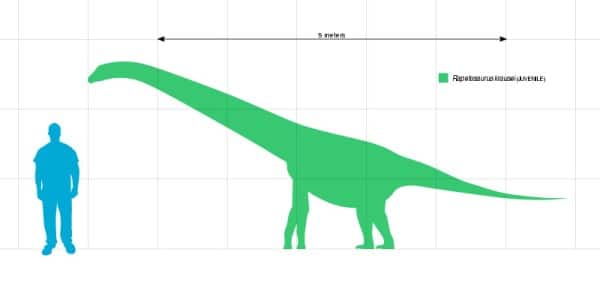
In terms of size, Rapetosaurus was relatively modest for a Titanosauria. A juvenile specimen stretched about 26.0 feet from head to tail, with an estimated weight comparable to that of an elephant. Adult specimens, however, reached about twice this length, measuring approximately 49.0 feet. This size, while impressive, was less than half that of some of its gigantic kin like Argentinosaurus and Paralititan.
A notable adult specimen, known from a femur and estimated in 2020 by Molina-Perez and Larramendi, was even larger. This individual likely measured around 54.0 feet in length and weighed about 11.35 tons. These dimensions underscore Rapetosaurus’s significant but not overwhelming presence among the Titanosauria, offering a unique perspective on the diversity of sizes within this group of dinosaurs.
More Dinosaur in Detail
Rapetosaurus stands out in the sauropod clade for several reasons. Its skeletal structure, particularly the unique features of its skull and vertebrae, indicates a specialized feeding strategy. These adaptations not only highlight its survival strategies but also shed light on the ecological dynamics of its habitat.
Notable specimens of Rapetosaurus have contributed significantly to our understanding of sauropod evolution. The study of these fossils has revealed details about their growth patterns, dietary habits, and overall physiology, offering a window into the life of this ancient creature.
Contemporary Dinosaurs
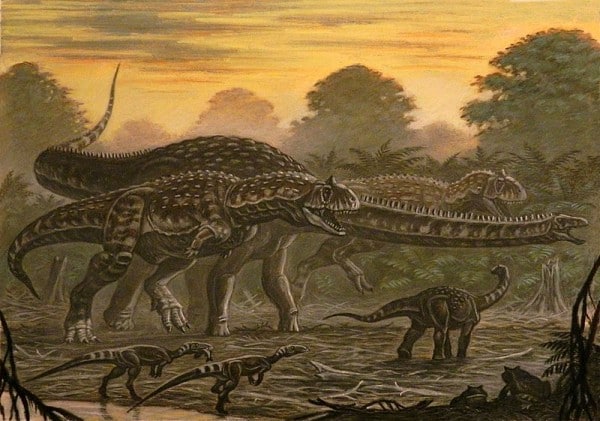
In the late Cretaceous Period, the island that is now Madagascar was a bustling stage for a unique ensemble of dinosaurs, with Rapetosaurus playing a significant role. This towering sauropod, akin to a living skyscraper, meandered through the ancient landscapes, its long neck swaying like a pendulum above the canopy. In stark contrast, the smaller but fierce Majungasaurus, a predator roughly the size of a bus, lurked in the underbrush.
This carnivorous dinosaur, with its powerful jaws and keen senses, was always on the lookout for an opportunity to strike. While it’s unlikely that Majungasaurus regularly hunted the colossal Rapetosaurus, the mere presence of this predator added a layer of tension to the ecosystem, especially for the younger, more vulnerable sauropods.
Amidst these giants and hunters, Masiakasaurus, with its bizarre, forward-jutting teeth, scuttled through the undergrowth. This peculiar dinosaur, smaller than both Rapetosaurus and Majungasaurus, likely scavenged for food, picking off smaller prey and perhaps feasting on the leftovers of Majungasaurus’ kills. The interactions between Masiakasaurus and Rapetosaurus were probably limited, given their vastly different sizes and diets, but they shared a world where the presence of one influenced the survival of the other. Masiakasaurus’ scavenging nature might have indirectly benefited Rapetosaurus, keeping the environment clean and perhaps reducing the spread of disease.
Soaring above this dynamic landscape was Rahonavis, a raptor-like dinosaur with bird-like qualities, casting its shadow over the giants below. Though significantly smaller than Rapetosaurus, Rahonavis played a crucial role in this Cretaceous ecosystem. Its ability to possibly snatch smaller creatures or scavenge alongside Masiakasaurus added another layer to the complex web of life that Rapetosaurus navigated daily. The interactions among these diverse species painted a vivid picture of life in ancient Madagascar, with Rapetosaurus maintaining its role as a gentle giant amidst a world of varied and fascinating contemporaries.
Interesting Points about Rapetosaurus
- Rapetosaurus’s name is derived from Malagasy folklore, reflecting the cultural heritage of its discovery location.
- The discovery of Rapetosaurus in Madagascar highlights the island’s rich and unique dinosaur fauna.
- Its skeletal structure provides key insights into the adaptability and evolution of sauropods in the Late Cretaceous.
- The well-preserved fossils of Rapetosaurus have been instrumental in understanding the sauropod’s growth and development.
- This dinosaur’s existence during the Maastrichtian Epoch offers valuable information about the pre-extinction dinosaur communities.
Rapetosaurus in its Natural Habitat
Rapetosaurus, a remarkable sauropod, thrived in the unique ecosystems of Late Cretaceous Madagascar. The island, having separated from the Indian subcontinent less than 20 million years earlier, was situated more southerly than its present location. This geographical positioning played a crucial role in shaping the habitat and climate that Rapetosaurus called home.
Madagascar’s Maastrichtian Climate and Geography
During the Maastrichtian, Madagascar’s climate was semi-arid, characterized by pronounced seasonality in temperature and rainfall. The landscape predominantly featured a coastal floodplain, interspersed with numerous sandy river channels. These channels were the sites of periodic debris flows, especially at the onset of the wet season. Such geological activities were instrumental in burying and preserving the remains of organisms that perished in the preceding dry season, contributing significantly to our fossil record today.
The rising sea levels of the Maastrichtian Period suggest that Rapetosaurus might have roamed coastal environments, including tidal flats. This adaptability to varying terrains highlights the dinosaur’s ecological versatility. The neighboring Berivotra Formation, representing the contemporaneous marine environment, provides further context to the habitat in which Rapetosaurus existed.
Predators and Prey: The Ecological Dynamics
Interestingly, the discovery of Majungasaurus, a large Abelisaurid Theropod, in 1996 shed light on the faunal connections between Madagascar and other landmasses. The presence of similar species in India and Argentina indicates the existence of land bridges between fragments of the former supercontinent Gondwana. This connectivity allowed for faunal exchanges, shaping the biodiversity of the region. Majungasaurus, being the largest predator in its environment, likely had interactions with Rapetosaurus, as evidenced by tooth marks found on Rapetosaurus bones.
In contrast to other titanosaurs, which typically coexisted with large ornithischian dinosaurs, Rapetosaurus’s contemporaries were limited in diversity. The Mahajanga basin, its primary habitat, was home to only one other large herbivore, another titanosaur. The scarcity of smaller herbivores, with only Simosuchus discovered in over a century of exploration, suggests a unique herbivore community dynamic in what is now Madagascar. The absence of Ornithischian dinosaurs in this region further underscores the distinct ecological niche that Rapetosaurus and its contemporaries occupied.
Frequently Asked Questions
Rapetosaurus was named after a mythical giant in Malagasy folklore, reflecting its enormous size and the location of its discovery.
As a herbivore, Rapetosaurus primarily fed on the lush vegetation of Late Cretaceous Madagascar.
Rapetosaurus lived during the Maastrichtian Epoch of the Late Cretaceous Period, approximately 72.1 to 66.0 million years ago.
Rapetosaurus was first discovered in Mahajanga, Madagascar, in 2001.
Kristina Curry Rogers and colleagues discovered Rapetosaurus in 1996.
Rapetosaurus is distinguished by its unique skeletal features, particularly in the skull and vertebrae, which provide insights into its feeding strategies and adaptation to its environment.
Sources
The information in this article is based on various sources, drawing on scientific research, fossil evidence, and expert analysis. The aim is to provide a comprehensive and accurate overview of Rapetosaurus. However, please be aware that our understanding of dinosaurs and their world is constantly evolving as new discoveries are made.
This article was last fact-checked: Joey Arboleda, 01-07-2024
Featured Image Credit: Nobu Tamura, via Wikimedia Commons
